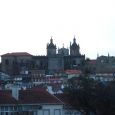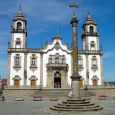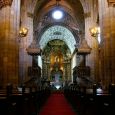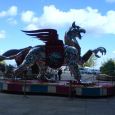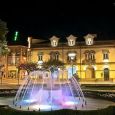Viseu
Advertisement
By Air
The Aerodrome Viseu (Goncalves Lobato Airfield) is located 7 km from the center of Viseu in the parish of Lordosa.The airfield is a structure that has a paved runway of 1200 meters long and 40 meters wide.It is the largest airport structure in Portugal after the airport Faro with more hours of sunshine.It is the largest airfield / airport in the central region of Portugal.
By Train
Viseu is now one of the largest cities in Europe without a railway connection.Once it was connected to Aveiro (via the Vouga line, a narrow gauge railway) and Santa Comba Dao (on the Dao line, another narrow gauge railway), where it had connection to the Linha da Beira Alta (broad gauge; international).The Dao line closed to passengers in 1988.
By Bus
The city of Viseu has a bus network - STUV - which operates several lines within the entire municipality and a recently installed funicular connecting the lower city with the upper city.The A25 motorway (former IP5) connects Viseu to the seaport of Aveiro and Guarda and then on to Salamanca in Spain.The IP3 and A24, connecting Coimbra with Chaves on the Spanish border, crosses Viseu from south to north.Until the nineteen eighties Viseu had railway connections with the coast, but these were closed.
Cathedral of Viseu
Cathedral of Viseu began to take shape in the twelfth century, right in the reign of D. Afonso Henriques, led by Bishop Odorio.Then comes the building of a cathedral in the Romanesque style.Although very little remains of this building, some authors classified a helm, vegan, datable from the late twelfth century, as well as a portal side (south) of the next century - which now gives access to the cloister - as likely elements of the original building.In the reign of D. Dinis, the city achieved a golden period it proceeds to a profound renewal of the building, even in the thirteenth century, under the supervision of Bishop Egas.However the crisis of 1383-1385 was disastrous for the works as terrified until after the crisis.Then, under the umbrella of the new bishop D. John Vincent, the works would last for many years.
St. Anthony's Church
The Church of St. Anthony is a temple of the city of Viseu, parish of Santa Maria de Viseu, located in Largo Mouzinho Albuquerque and date of the centuries XVII and XVIII.The church is a rebuilding of the centuries XVII and XVIII of the church of the former Convent of Bom Jesus, founded in 1592 for the nuns of S.Benedict and therefore is also called the Church of the Convent of Benedictine nuns.The facade of the seventeenth century.The interior is rich in gilded wood and tiles.The church has an imposing main altar and two side altars gilded rococo, dating from the second half of the eighteenth century by Antonio Neves and attributed to the large Beira engraver Jose Ribeiro da Fonseca.
Palace Tower Street D. Duarte
is a national monument that came into the possession of the family Abreu in 1476, when the Town Council of the Cathedral emprazou Antony Gomes de Abreu, a nobleman of House of D. Afonso V and his wife, a tower in this city street chain as head of a vast period that stretched from the river Pavia Mount Salvato, including the estates of Aguieira and Travassos of St. Stephen.Brother of D. John Gomes de Abreu, Bishop of Viseu from 1462 until his death on February 16th of 1482, both sons of the lord of Regalados and Valadares Diogo Gomes de Abreu, Anthony Gomes de Abreu moved to Gauteng after his brother had been consecrated bishop, being married to D. Isabel Soares de Melo, daughter of Jonathan Smith of Hostels, lord of the Prado.
Cava de Viriato
The Cava de Viriato is a camp military Roman or Arabic located in the city of Viseu.It is a national monument since 1910.The camp has a form octagonal, enclosed by high banks, with 2000 meters of perimeter and an area of 38 hectares, the faces of spring, the north and west has a gap.The Cava is traditionally considered a Roman camp, built by Tenth Junius Brutus (137-136 a.C.) or, according to Jorge Alarcao by warlords Petreio and Cassius Longinus in the middle of the century.C.More recently, Vasco Mantas, even though to do within the area of Cava there is a Roman camp, attributes its construction to the Arabs.Only in the sixteenth century is that they called the name of Viriato for Cava, however, the chief of the Lusitano probably never set foot in Viseu.
Grand Museum Vasco
is located in the historical center of Viseu, in the ancient palace of the bishops of the sixteenth century, beside the cathedral.The paintings of Vasco Fernandes and other artists of the school of Viseu, are valued for their naturalism and the background scenery.Treatment shows an influence of light Flemish.On the third floor of the museum are displayed masterpieces that once adorned an altar of the cathedral.The predominant one is monumental St.Peter and The Adoration of the Magi, a series of 14 panels on the life of Christ.it is thought that some of the remaining panels are other artists of the School of Viseu.Among other masterpieces can be seen works by Gaspar Vaz, the great rival of Onix, including a Last Supper.
Almeida Moreira House Museum
The House Museum Almeida Moreira is a museum Portuguese in the city of Viseu.The museum is housed in the house was the residence of Captain Francisco Antonio de Almeida Moreira, which, with the filling made up of library, and several pieces, paintings, furniture, porcelain and sculpture, donated to the museum-library open to the public.
Viriato Theatre
Founded in 1883 under the name of the Good Theatre Union, becoming the first venue in the city of Viseu.In 1898, adopting its current name in honor of Viriato, the chief of Lusitanos have lived on the outskirts of Viseu.In 1912 it opened a second theater in the city, the Avenue Theatre, with an auditorium largest and most modern leading to the Theatre Viriato gradually go falling into decay, and eventually close its doors in 1960, reopening 25 years later, in September 1985 to, in their ruins, to be presented "Only Theatre enormities credible the Electric Light," a show staged by Ricardo Pais, produced by Urban Area - Center for Cultural Action of Viseu, with texts Aquilino Ribeiro, who was so honored on the occasion of the centenary of his birth.This show was also attended by Olga Roriz (choreography and interpretation), Luis Madureira (singing and interpretation), Antonio Emiliano (music and interpretation).
Alcafache Thermal Spa
The Alcafache thermal spa centers are a major tourist attraction of the Board of Viseu, receiving thousands of visitors from all over the country who come here in order to perform thermal treatment and wellness programs.The properties of sulphurous water that flows Alcafache of more than 50 º are already a reference in the thermal sector, and which greatly contributed to Viseu has been considered one of the cities with the highest quality of life in Europe.The operation for over 50 years, is one of the main pillars of the economy of this region and commitment to rehabilitation has been a constant.The Alcafache, only in the Viseu Council, are a must for those who want to know the benefits of thermal water and walk on the beautiful banks of the Dan River.
May - August
October - February


